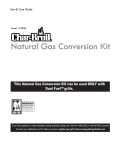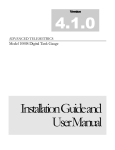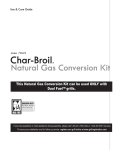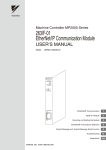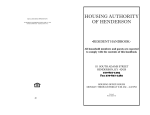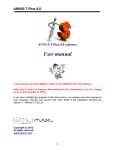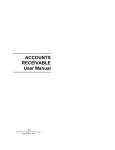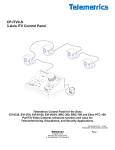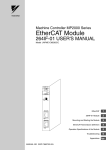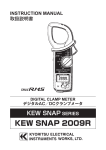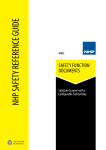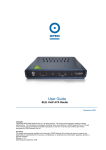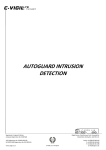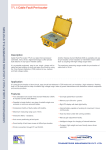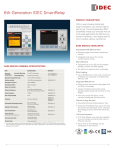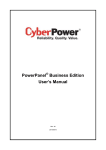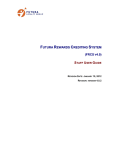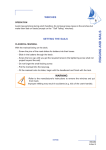Download Advanced Telemetrics 1000S Manual
Transcript
Version 3.5.1 ADVANCED TELEMETRICS Model 1000S Digital Tank Gauge InstallationGuideand UserManual ADVANCED TELEMETRICS – MODEL 1000S DIGITAL TANK GAUGE User Manual and Installation Guide 2013 Resource Production Co. Inc. 700 South Tucker Avenue Farmington, NM 87401 Phone 800.382.1482 D I G I T A L T A N K G A U G E – M O D E L 1 0 0 0 S Contents Revision Tracking...................................................................... ii Introduction .............................................................................. 1 System Description and Function ................................................... 1 Communication ............................................................................... 1 Important Safety Information .................................................... 2 Prior to Installation – READ THIS FIRST ........................................ 2 Installation – Hardwired Gauges .............................................. 3 Shipped Parts ................................................................................. 3 Tools for Installation ........................................................................ 4 Procedures – Hardwired ........................................................... 4 Part 1 – Installation Preparation ...................................................... 4 Part 2 – Tank Gauge Installation ..................................................... 5 Part 3 – Programming ..................................................................... 6 Installation – Wireless Gauges ................................................. 8 Shipped Parts ................................................................................. 8 Tools for Installation ........................................................................ 9 Procedures – Wireless ............................................................. 9 Part 1 – Wireless Pairing................................................................. 9 Part 2 – Installation Preparation .................................................... 10 Part 3 – Tank Gauge and Master Radio Installation ..................... 11 Appendix A: Serial Commands............................................... 13 Appendix B: Wire Connections ............................................... 14 Hardwired Connections ................................................................. 14 Wireless Connections ................................................................... 14 Appendix C: RS-485 .............................................................. 15 Protocol Settings ........................................................................... 15 Modbus Registers ......................................................................... 15 Appendix D: Hyperterminal .................................................... 16 Appendix E: TeraTerm ........................................................... 17 Appendix F: PuTTY ................................................................ 18 Appendix G: Hardwired Troubleshooting/Support .................. 19 Appendix H: Wireless Troubleshooting/Support ..................... 20 Appendix I: Model 1000S Diagram ......................................... 21 Appendix J: Hardwired Wiring Diagram .................................. 22 Revision Tracking This Manual may be revised periodically to incorporate new or updated information. A major change in content of the manual also changes the date and revision number of the manual, which appears on the front cover. Listed below are the dates and revisions of each change. Page Revision Date Updated Appendices Updated Cover – Removed “Draft” Formatted Warnings Updated Wireless Section Wording December 2012 Added Wireless SW1 Register February 2013 Corrected Numbering Clarified Procedures March 2013 2 Power Supply Specs Added June 2013 2 2 2 2 Power Supply Specs Modified Environmental Conditions Added Use Instructions Added Warnings Added July 2013 iv n/a All All Contents Added Wireless Power Reqs Clarified Style Change Clarification/Simplification August 2013 2 11 NRTL Certification Clarified Appendices added September 2013 All Wireless Information Added October 2013 7, 8 i 1 n/a 8 n/a 4, 5, 6 D I G I T A L T A N K G A U G E – M O D E L 1 Section 1 0 0 0 S Introduction This manual covers operation and installation instructions for the Model 1000S Digital Tank Gauge system by Advanced Telemetrics. The Model 1000S is typically installed in above ground storage tanks for real-time fluid level management. System Description and Function T he Advanced Telemetrics Model 1000S Digital Tank Gauge is comprised of a CPU that connects to an array of sensing devices that are sensitive to magnetic proximity. The float or multiple floats ride on the outside of sealed stainless tubing with a sensing element on the inside of the enclosure. The tube is sealed by means of a welded cap on the bottom of the tubing and a CPU headenclosure on the top. The CPU head-enclosure typically sits a few inches above the top of the tank with a junction box attached to make up connections to other gauges and a controller. The gauge is sealed in the tank via a compression fitting threaded into coupling entry into the storage tank. are designed to provide product level and water interface levels in inches as well as fluid temperature Valuable information below the primary product float. An optional 3rd float provides a high-level alarm circuit that is discrete and fully independent ⚠ Safety information from the sensing array in the hardwired model, and fully integrated if used with the wireless option. I C O N K E Y Digital Tank Gauges Communication The Model 1000S Digital Tank Gauges communicate via RS485 and switch automatically between protocols. The supported communication protocols are Tank Gauge ASCII, MODBUS ASCII, or MODBUS RTU. Each gauge responds to a programmable unique MODBUS address. Details on protocols and a list of commands are in the appendices. 1 ⚠ D I G I T A L T A N K G A U G E – M O D E L 1 0 0 0 S Important Safety Information Metal surfaces on the equipment may become excessively hot in direct sunlight or excessively cold in freezing temperatures. Use proper PPE at all times. Maximum operational altitude is 30,000ft. Pollution degree: 4. For use in wet locations, do not remove enclosure caps. There are no serviceable or maintainable parts on this equipment beyond what is described in this manual. In case of malfunction, please contact the factory. CAUTION: If the equipment is not used in the manner specified by the manufacturer, the protections provided by the equipment may be impaired. Use only with an NRTL-listed limited power supply. 12VDC (with 24VDC option available upon request). The Model 1000S operates on Wireless gauges operate on 3.6VDC batteries and must not be connected to higher voltages. Connecting more than 3.6VDC to a wireless gauge will result in permanent damage to the electronics. Prior to Installation – READ THIS FIRST The system must be installed following the current national electric code (NEC guidelines, all local interpretations thereof, and applicable state A POTENTIAL and local electrical codes. Technicians are responsible for SHOCK HAZARD following all safety rules and regulations required by their EXISTS: Electricity and High-Voltage exists in – and employer and/or the owner or leaseholder of the installation is potentially supplied to – site. These include, but are not limited to, safety requirements the Digital Tank Gauge. for working in hydrogen-sulfide gas environments and static electricity/spark sensitive environments. Always wear approved FRCs, hard-hat, and safety glasses when handling this equipment. Any unauthorized parts used in the Digital Tank Gauge system, or any modifications made to the equipment, will nullify the Limited Warranty. Advanced Telemetrics will not be responsible for any liability claims regarding the performance of modified units. Inspect Digital Tank Gauge and related packages for any signs of shipping damage. Contact shipping company if any damage is noticed. Ensure that you have received all factory-supplied components by comparing packing slip to contents received. Examine the diagrams showing typical Digital Tank Gauge installation procedures and determine probable install port locations as well as cable and conduit runs. Determine location of electrical distribution and breakers. Keep electrical breakers locked-off during installation. 2 Installation – Hardwired Gauges The following sections describe parts, tools, and preparations and procedures for installing the 1000S Digital Tank Gauge. . Shipped Parts The Model 1000S ships in two parts – the sensor assembly and the boxed hardware kit. Check that received shipment is complete and that no parts are missing. Contact the factory if there are missing parts. These instructions include descriptions, pictures, and steps for a gauge which includes the HLS 3rd Float Option upgrade. If your sensors were ordered without this upgrade, ignore parts and steps related to Stop-Rings, markings, HighLevel float, and test cable. Parts labeled with * are included with the HLS 3rd Float Option Upgrade only. Please Note: Tank Gauge – Includes: - (1) Sensing Array Enclosure (the gauge). - (1) Compression Fitting on tube with Viton O-ring. - (2*) Pairs of Tube Markings indicating Stop-Ring positioning. - (1) Wire Protector (covering gauge wiring). Boxed Hardware Kit – Includes: - (1*) High-level Float (attached to Test-Cable and 4”-1” Bushing). - (1) Product Float. - (1) Interface (Water) Float. - (1) 4”-1” Reducer Bushing. - (1) Anodized Aluminum Junction Box (The Junction Box should contain 6 Wago snap-termination blocks). - (2*) Stop-Rings (including washer and tightening-screw). - (1) Tank Guard End-Cap with Hairpin Clip 3 ⚠ Tools for Installation CAUTION: The most important installation tools are an individual’s Personal Protective Equipment. Do not attempt installation without first PPE. This includes FRCs, Fall-Harness, Safety Glasses, and Safety-Toed Boots/Footwear. The following tools are recommended for installation: - 36” Aluminum Pipe Wrench - >12” Channel Locks or Adjustable Wrench - Phillips Screwdriver - Personal Computer with terminal-emulation program. (Some suggested programs include TeraTerm, puTTY, and Hyperterminal). - Reliable USB-485 Converter. (Beware of untested converters, as many “brand new” converters are unreliable). Procedures – Hardwired Part 1 – Installation Preparation Rest Tank Gauge on a horizontal surface. Open and unpack the boxed hardware kit. 1. 2. Slide the 4”-1” bushing a few inches onto the bottom of the gauge tubing. 3. Slide one Stop-Ring onto the gauge tubing without tightening the setscrew. 4. Slide the High-Level Float onto the tubing with the float plate facing UP. The HL Float has a red label and an attached test cable that runs through the 4”-1” Bushing. 5. Slide the second Stop-Ring onto the tubing without tightening the setscrew. 6. Slide the Product Float onto the tubing with the float plate facing UP. The Product float has a green label and is the largest float by volume. 7. Slide the Interface (Water) Float onto the tubing with the label facing UP. The Interface (Water) Float has a blue label and a plate on both ends. 4 ⚠Wear Safety Glasses for step 8. 8. Position the Tank Guard End-Cap on the bottom of the tubing. Use the hairpin clip to secure the End-Cap in place. Be mindful that the hairpin clip can spring free if not installed correctly. Verify that the hairpin clip is fastened tightly onto the tubing enclosure. Part 2 – Tank Gauge Installation Important: Retain the Stop-Rings and high level floats while lowering tubing into tank! (See Step 11) Determine which side of gangway is closest to install port. Position assembled sensor against side of tank/gangway closest to install port. All of the hardware on the tubing should 9. be resting at the bottom of the tubing. 10. Lift tank gauge vertically (hand over hand) and position over install port. Avoid contact of the floats against the side of the tank as the gauge is raised. Position the End-Cap over the install port. 11. Have a partner hold onto the bottom Stop-Ring as the tube, Product Float, and Water Float are lowered into tank. Be mindful that the Product Float and Interface Float do not get stuck in the port as the gauge is lowered; this could cause them to fall and break. 12. Fasten the Stop-Rings in their marked positions at the top of the tube. The High-Level Float should sit securely on the bottom Stop-Ring. It is important to verify Stop-Ring positioning is correct for the high-level alarm to function properly. 13. Lower the sensor until it is resting on the bottom of the tank. The sensor must be touching the bottom of the tank for readings to be accurate. Use pipe wrench to tighten 4”-1” compression fitting and use adjustable wrench to tighten 1” fitting. 14. Pull up on the stainless High-Level Test Cable to ensure High-Level Float is free to move up and down between the Stop-Rings. Tighten the small hex plug where the Test Cable comes out of the 4”-1” to create a seal around the cable after testing is complete. 15. Remove the thread protector from the Head Enclosure on the Tank Gauge and attach the Junction Box from the Hardware Kit. Wrenchtighten the swivel fitting between enclosures, but do not over-tighten. Avoid pinching/damaging Head Enclosure wiring when attaching the Junction Box to the swivel fitting. 16. Use the Snap-Termination Blocks to make up the 485 connections inside the Junction box . Leave the Tank Gauge unpowered until Step 18. See Appendix A for description of Connections. 5 17. Repeat steps 1-16 for all gauges on site, leaving all unpowered. Part 3 – Programming Use a trusted USB-RS485 converter to connect PC to the Tank Gauge RS485 line at the control box: A (Tx/Rx Pos., Green) and B (Tx/Rx Neg., White) Verify that there are no additional 485 signals on the line (no polls/queries from RTU/PLC or app cards/modules). The gauge will not respond if there are multiple conflicting query sources are on the 485 line. 18. Connect power to a single gauge at a time for renaming and programming. Connecting power to one gauge at a time is the best way to avoid addressing conflicts. The factory default MODBUS address can be found on the headcap. 19. In your terminal program, use the U##IDT## command to address the gauge as required. Substitute the first “##” with the starting/default MODBUS address of the gauge, and substitute the second “##” with the ending/desired MODBUS address. Example: Entering U01IDT22 and pressing <enter> changes the tank gauge address of unit ID 01 to ID 22. The newly-renamed unit 22 will respond with “U22NewIDTankYOk”. 20. Issue a query command to confirm communication at the control box for the renamed gauge: Use U##? and press <enter> (using the MODBUS address in place of ##). Look for a response from the gauge to confirm new MODBUS address. Important: To verify that floats are correctly installed (and not reversed), subtract interface level from total level reading (Product – Water = Pad Thickness). If pad thickness is less than 5 inches, floats are NOT correctly installed! In an empty tank, Product Level should read ~9.5” with an Interface Level of ~3.5”. 21. Disconnect the RS485 line from your PC and connect RS485 loop to controller (RTU/PLC). Verify that controller is communicating successfully with newly-programmed tank gauge. Note: Some controllers use reversed TX/RX(+) and TX/RX(-). Swap RS485 wire termination as necessary for your controller. See ‘Appendix C: RS485’ for details. 22. If a SCADA system is in use, verify that values on SCADA match values from PC and from controller (RTU/PLC). Do this before moving on to the next tank gauge for programming.. 6 Note: PLC/RTU programs vary, so be sure to consider conversions between inches, feet/inches, and decimal feet. 23. If access to floats is available, physically move floats along the length of the sensor and verify that changes occur in SCADA. Floats may have to be held (suspended in place) for a period of time in order to register an update, depending on SCADA poll rate. Contact your SCADA technician for poll rate details if necessary. 24. For tanks containing fluid, perform a manual gauge (strap) to verify strap value matches (approximately) the total fluid and interface levels. 25. Repeat steps 18 through 24 for all the gauges on site, one at a time. 26. Once all tank gauges are renamed to desired scheme, disconnect USB-485 converter and connect the user’s controller to the 485 loop. The Tank Gauges are now ready for use with user controller/PLC. Cycle the 12VDC to all Tank Gauges as a final step. 7 Installation – Wireless Gauges The following sections describe parts, tools, and preparations and procedures for installing the 1000S Digital Tank Gauge with Wireless Upgrade . Shipped Parts The Model 1000S ships in two parts – the sensor assembly and the boxed hardware kit. Check that received shipment is complete and that no parts are missing. Contact the factory if there are missing parts. These instructions include descriptions, pictures, and steps for a wireless gauge which includes the HLS 3rd Float Option upgrade. If your sensors were ordered without this upgrade, ignore parts and steps related to Stop-Rings, markings, HighLevel float, and test cable. Parts labeled with * are included with the HLS 3rd Float Option Upgrade only. Please Note: Tank Gauge – Includes: - (1) Sensing Array Enclosure (the gauge). - (1) Compression Fitting on tube with Viton O-ring. - (2*) Pairs of Tube Markings indicating Stop-Ring positioning. - (1) Wire Protector (covering gauge wiring). Boxed Hardware Kit – Includes: - (1) Wireless Master Radio - (1*) High-level Float (attached to Test-Cable and 4”-1” Bushing). - (1) Product Float. - (1) Interface (Water) Float. - (1) 4”-1” Reducer Bushing. - (1) Anodized Aluminum Junction Box (The Junction Box should contain 2 Wago Snap-Termination Blocks and a 3.6VDC battery pack). - (2*) Stop-Rings (including washer and tightening-screw). - (1) Tank Guard End-Cap with Hairpin Clip 8 ⚠ Tools for Installation CAUTION: The most important installation tools are an individual’s Personal Protective Equipment. Do not attempt installation without first PPE. This includes FRCs, Fall-Harness, Safety Glasses, and Safety-Toed Boots/Footwear. The following tools are recommended for installation: - 36” Aluminum Pipe Wrench - >12” Channel Locks or Adjustable Wrench - Phillips Screwdriver - Personal Computer with SW-0230 Wireless Tank Gauge Interface Program (SW-0230.exe) and Master Radio Drivers installed. (Please contact [email protected] for install/driver support.) - Powerful Magnet. (~2” diameter ceramic ring or smaller rare-earth magnet should be sufficient.) Procedures – Wireless Part 1 – Wireless Pairing It is recommended that Wireless Tank Gauges be paired with their wireless master radio before on-site installation. Wireless gauges can be paired anywhere, before or after installation, but is usually preferable to pair gauges before install to avoid multiple trips to the top of the tanks for pairing procedures. The order that the gauges appear in the Wireless Tank Sensor Interface program cannot be changed – they are listed in the order they are added. Modbus addresses, on the other hand, can be edited at any time. A. Connect Master Radio to PC via USB. The USB will power the Master Radio. Open the SW-0230 Wireless Tank Sensor Interface program. B. Select Options>Comm Config>Comm Port and select the USB port that is connected to the Master Radio. Click “Connect”. If the drop-down is already populated with the correct USB port, open the drop-down and select the port before clicking “Connect” to ensure Master is truly paired with program. 9 C. Use Wago connectors to make up connection to battery pack for the Tank Gauge to be added to the Master Radio. a. Red Wire – 3.6VDC positive (+) b. Black Wire – 3.6VDC negative (–) Important! Wireless gauges are wired for a 3.6VDC battery. Supplying more than 3.6 volts WILL cause permanent damage to the Tank Gauge electronics! D. In the Wireless Tank Level Sensor Interface program, click “Add Sensor”. The Master Radio will remain in “listening/add” mode indefinitely until a slave device (Tank Gauge) is paired successfully. E. In a slow controlled movement, swipe the powerful magnet down the length of the aluminum head of the Tank Gauge. The Tank Gauge will appear in the Wireless Tank Level Sensor Interface program. Each newly added Tank Gauge will be added to the bottom of the list. F. Change Modbus Address newly-added Tank Gauge as necessary. Remember, the order in which gauges are added will be the permanent order in which they appear in the Master Radio. Modbus addresses, however, are configurable at any time. G. Repeat steps C-F until all gauges are added to the Master Radio. After all gauges are added to Master Radio, change the setting for “Sleep Interval” to 5 or 10 minutes to ensure full battery life. The Tank Gauges and Master Radio are now ready for installation on location. Once installed, the Tank Gauges and Master Radio will automatically re-establish communications as they are powered up onsite. Part 2 – Installation Preparation At location, rest Tank Gauge on a horizontal surface. Open and unpack the boxed hardware kit. H. Slide the 4”-1” bushing a few inches onto the bottom of the gauge tubing. I. J. Slide one Stop-Ring onto the gauge tubing without tightening the setscrew. 10 ⚠Wear Safety K. Slide the High-Level Float onto the tubing with the float plate facing UP. (The HL Float has a red label and an attached test cable that runs through the 4”-1” Bushing.) L. Slide the second Stop-Ring onto the tubing without tightening the setscrew. M. Slide the Product Float onto the tubing with the float plate facing UP. (The Product float has a green label and is the largest float by volume.) N. Slide the Interface (Water) Float onto the tubing with the label facing UP. (The Interface (Water) Float has a blue label and a plate on both ends.) O. Position the Tank Guard End-Cap on the bottom of the tubing. Use the hairpin clip to secure the End-Cap in place. Be mindful that the hairpin clip can spring free if not installed correctly. Verify that the hairpin clip is fastened tightly onto the tubing enclosure. P. Repeat steps H-O for all Tank Gauges on site. Glasses for step 8. Part 3 – Tank Gauge and Master Radio Installation Important: Retain the Stop-Rings and high level floats while lowering tubing into tank! (See Step 11) At this point, make note of which Tank Gauges are to be installed in which tanks. Remember, the Tank Gauges have been pre-paired and pre-addressed in the Master Radio in steps Part 1 – Wireless Pairing above. If the Tank Gauges have not already been pre-added and pre-addressed, don’t worry – they can be paired and addressed once installed in the tanks using the same steps described in Part 1 – Wireless Pairing. Q. Determine which side of gangway is closest to install port. Position assembled sensor against side of tank/gangway closest to install port. All of the hardware on the tubing should be resting at the bottom of the tubing. R. Lift tank gauge vertically (hand over hand) and position over install port. Avoid contact of the floats against the side of the tank as the gauge is raised. Position the End-Cap over the install port. S. Have a partner hold onto the bottom Stop-Ring as the tube, Product Float, and Water Float are lowered into tank. Be mindful that the Product Float and Interface Float do not get stuck in the port as the gauge is lowered; this could cause them to fall and break. 11 T. Fasten the Stop-Rings in their marked positions at the top of the tube. The High-Level Float should sit securely on the bottom Stop-Ring. It is important to verify Stop-Ring positioning is correct for the high-level alarm to function properly. U. Lower the sensor until it is resting on the bottom of the tank. The sensor must be touching the bottom of the tank for readings to be accurate. Use pipe wrench to tighten 4”-1” compression fitting and use adjustable wrench to tighten 1” fitting. V. Pull up on the stainless High-Level Test Cable to ensure High-Level Float is free to move up and down between the Stop-Rings. Tighten the small hex plug where the Test Cable comes out of the 4”-1” to create a seal around the cable after testing is complete. W. Remove the thread protector from the Head Enclosure on the Tank Gauge and attach the Junction Box (with battery) from the Hardware Kit. Wrench-tighten the swivel fitting between enclosures, but do not overtighten. Avoid pinching/damaging Head Enclosure wiring when attaching the Junction Box to the swivel fitting. X. Repeat steps Q-W for all Tank Gauges on site. Y. At the control box, connect Master Radio to supplied 900MHz antenna assembly and verify good line-of-sight with Tank Gauges. Z. Make up RS-485 connection to RTU/PLC and power the Master Radio with 6-30VDC. The Master Radio is ready to be polled. See Appendix for Modbus configuration information. 12 Appendix A: Serial Commands The following are the most commonly used commands for programming and querying the Tank Gauge. Use all capital letters. U##IDT## <enter> Changes Tank Gauge with ID ## to new ID ##. U##? <enter> Returns product, interface, and temperature string for device ID ##. Use ID 00 to query gauge with unknown ID (all gauges respond to ID 00). Only use 00 with a single gauge on the line to avoid multiple gauges responding at once. U##SETUP <enter> Returns user-entered setup information for device ID ##. This command returns unit ID, programmed number of sticks, programmed number of floats, programmed halls disabled (for third float), level offsets, resistor status, and other info. U##OLXXXX.XXX <enter> Sets offset for ID ## product/total level as XXXX.XXX. Substitute offset inches and thousandths for XXXX.XXX. Use offsets only as a last resort! Offsets are only recommended in rare circumstances. U##OWXXXX.XXX <enter> Sets offset for ID ## water/interface level as XXXX.XXX. Substitute offset inches and thousandths for XXXX.XXX. Use offsets only as a last resort! Offsets are only recommended in rare circumstances. U##TR4851 <enter> Turns ON termination resistor for ID ##. Use this command to activate an internal termination resistor option to eliminate noise and reflections. Use only on the last device on the 485 line. This function is currently in testing phase. Contact the factory for additional information. U##TR4850 <enter> Turns OFF termination resistor for ID ##. Use this command to restore factory default setting of OFF to the termination resistor option. This function is currently in testing phase. Contact the factory for additional information. 13 ⚠ Appendix B: Wire Connections CAUTION: SEE IMPORTANT SAFETY INFORMATION SECTION BEFORE CONNECTING POWER TO TANK GAUGES. The Model 1000S Hardwired Tank Gauge operates on 12VDC (with 24VDC option available upon request). Connecting more than 12VDC to a Hardwired Tank Gauge will result in permanent damage to the electronics unless using the available 24-12VDC converter option. Wireless Tank Gauges operate on 3.6VDC batteries and must not be connected to higher voltages. Connecting more than 3.6VDC to a Wireless Tank Gauge will result in permanent damage to the electronics. Hardwired Connections Interestingly, there is very little industry agreement on the “correct” usage of the “A” and “B” designations for Tx/Rx Positive and Tx/Rx Negative. Always try switching A and B and cycling power when troubleshooting communications between the Tank Gauge and another device. Green – A: RS-485 Tx/Rx (+) Positive White – B: RS-485 Tx/Rx (–) Negative Black – 12VDC Negative Red – 12VDC Positive Blue/Blue – Discrete High-Level Alarm Circuit, Normally Closed Wireless Connections Wireless Tank Gauges are connected using the red and black wires only. Battery life expectancy depends on “Sleep Interval” setting in Master Radio. As a general rule, each minute of “Sleep Interval” corresponds to an extra year of battery life up to 10 years! Green – Not Used White – Not Used Black – 3.6VDC Negative Red – 3.6VDC Positive Blue/Blue – Not Used 14 Appendix C: RS-485 The Model 1000S Digital Tank gauge switches automatically between MODBUS ASCII, MODBUS RTU, and Tank Gauge ASCII protocols. Only one protocol can be used at a time. Always disconnect RTU/PLC/Controller from RS-485 line before attempting to communicate with Tank Gauges using a PC for programming or troubleshooting. Protocol Settings The default data settings for communicating with the Tank Gauges and Master Radio are listed below. Baud Rate – 9600 Parity – None Data Bits – 8 Stop Bits – 1 Modbus Registers Function Code – 03 (Holding Registers) Data Type – Floating Point Byte Order – Word Swapped 0001-0002 (40001-40002) – Product/Total Level in Inches 0003-0004 (40003-40004) – Water/Interface Level in Inches 0005-0006 (40005-40006) – Temperature in Degrees Fahrenheit 0007-0008 (40007-40008) – High Level Switch Status (Wireless Only) 15 Appendix D: Hyperterminal Hyperterminal is a terminal emulator that was bundled with Windows Vista and XP (and older versions of Windows) but was removed from Windows 7 and 8. Users of Windows 7 or 8 are encouraged to download TeraTerm or PuTTY instead of Hyperterminal. Users are advised to download and use TeraTerm or PuTTY as instead of Hyperterminal, as they are simpler to configure and navigate. The following instructions will configure Hyperterminal to communicate with the Digital Tank Gauge. 1. Open Hyperterminal and Open a new connection. Name the connection “Advanced Telemetrics” and click OK. 2. In the ‘Connect to’ window, select the dropdown menu for “Connect using” and select the Comm Port ID that corresponds to the Comm Port where USB-to-RS485 converter is connected to PC. 3. Com properties ‘9600 N-8-1’ should appear in the info box on the bottom of the Hyperterminal window. If they do, the program is ready to communicate with the Digital Tank Gauges. 4. If they do not and the info box says “auto-detect”, Click ‘Disconnect’ / ‘Hang Up’. 5. Open File>Properties>Configure and select correct com settings (Bits Per Second: 9600, Parity: None, Data Bits: 8, Stop Bits: 1). Click OK and exit the Configuration menu. 6. Open File>Properties, go to Settings tab, and click the ‘ASCII Setup” button. 7. Check the boxes for ‘Send line with line feeds’ and ‘Echo typed characters locally’. 8. Click ‘Call’ to open communication with Digital Tank Gauges. 9. If the Com properties info box does not display 9600 N-8-1 and instead displays “auto-detect”, click ‘Disconnect’ / ‘Hang Up’ and repeat step 5 and step 8. 16 Appendix E: TeraTerm TeraTerm is a free, software-implemented, open-source serial tool and terminal emulator available for download online. It is the recommended program (unofficially) for use with the Advanced Telemetrics Tank Gauges due to its simplicity and ease-ofconfiguration. See http://www.auelectronics.com/forum/index.php?topic=206.0 for more information about TeraTerm and a link to download. 1. Download TeraTerm. 2. When installing, at the ‘Select Components’ step, de-select everything except for ‘TeraTerm and Macro’. Click Next and continue with installation. Windows 7 users, ignore C:\\Windows\Fonts error. 3. Click Finish and Launch TeraTerm. 4. Open a New Connection and select ‘Serial’. Use the ‘Port’ dropdown to select the serial port where the USB-485 converter is connected. One of the benefits of TeraTerm is that the dropdown should automatically populate without the need to verify com port assignments in Control Panel. 5. Select Setup > Terminal… and check the box for ‘Local Echo’. 6. Select Setup > Serial Port… and select 9600 baud, 8 data bits, ‘none’ Parity, 1 stop bit, and ‘none’ flow control. (These settings should be default). 7. Select Setup > Save Setup and name the setup “Advanced Telemetrics”. 17 Appendix F: PuTTY PuTTY is an SSH and telnet client developed originally by Simon Tatham for Windows. It is open-source software that is available with source code and developed/supported by volunteers. Putty.exe is available for download here: http://www.chiark.greenend.org.uk/~sgtatham/putty/download.html 1. Download and install PuTTY. 2. Run the PuTTY client (putty.exe) 3. Select the bubble for “Serial”. In the “Serial line” box, select COM port where USB-RS485 converter is connected. Enter 9600 in the “Speed” box. 4. On the Category tree, select “Terminal”. 5. Check the boxes for “Auto wrap mode initially on”, “Implicit CR in every LF”, “Implicit LF in every CR”, and “Use background color to erase screen”. 6. Check the “Force on” box for Local echo. 7. On the Category tree, select “Session”. 8. Go to the Saved Sessions box and enter “Advanced Telemetrics” and click Save to save the profile settings under Advanced Telemetrics. This will be the profile to load each time PuTTY is used. 9. Remember to select COM port number each time PuTTY is used. ***Note COM port numbers can change each time USB-485 converter is attached to PC. To determine the COM port number where USB-RS485 converter is plugged in, open the Start Menu, right-click My Computer, click Manage, click Device Manager, click the dropdown arrow for Ports (COM and LPT). This will display all attached devices and their ports. 10. Click “Open” to open the saved “Advanced Telemetrics” connection. 18 Appendix G: Hardwired Troubleshooting/Support Do not, under any circumstances, remove the head cap from the head of the gauge unless it is with express factory approval. Always verify that there is only one MODBUS master device on the RS485 line at any given time. To communicate with a Digital Tank Gauge or Gauges using a computer and serial tool, be sure to disconnect any PLC or RTU from the 485 line to avoid communication conflicts. The Digital Tank Gauge switches automatically between MODBUS ASCII, MODBUS RTU, or TANK GAUGE ASCII (serial commands listed in Appendix A). Only one “language” at a time can be used. Always verify correct wiring and junction box connections are secure. Cycle power to the Tank Gauge(s) any time RS485 wiring configurations are adjusted or changed. Current draw of a healthy unit should start up around 16mA for 4 seconds and then settle around 23-24mA. For issues involving incorrect current draw, contact the factory before proceeding. High-level switches are custom-set at the factory. Do not attempt to adjust high-level switch location without contacting the factory. Failure to correctly adjust float position, switch position, and sensor programming will result in a major unit failure. Troubleshooting Queries (Contact the Factory): If readings are incorrect or inconsistent, use SETUP, RAWHALL, and RAWHALLF commands (See Appendix A) and copy+paste device responses into a text file for reference. The text file can be emailed to [email protected] for review by the factory to assess device health. Be sure to include all relevant location information, device specs and serial number, and technician company/contact information. After sending device health query to the email listed above, feel free to contact Support at (505) 635-1048. Issues can usually be identified and resolutions assessed within a few minutes of receipt of a troubleshooting email query. 19 Appendix H: Wireless Troubleshooting/Support Do not, under any circumstances, remove the head cap from the head of the gauge unless it is with express factory approval. Always verify correct wiring and junction box connections are secure. Verify factory antenna is being used and that line-of-sight between Master Radio and Tank Gauges is not obstructed. Current draw on the 3.6VDC positive wire of a healthy Tank Gauge should start up around 85mA for 3 seconds, 65mA for 2 seconds, and then go to “Sleep” around ~0.06mA. Push updates to the Master Radio occur once every “Sleep Interval” period and should peak around 100mA for half a second, then fall back to ~0.06mA sleep for another “Sleep Interval” period. The amount of time during which the Tank Gauge “Sleeps” in between push updates is defined by the “Sleep Interval” parameter in the SW-0230 program. For issues involving incorrect current draw, contact the factory before proceeding. The Tank Gauge cannot be paired during a push update. These updates are brief when they are successful, but they can push (at 80-100mA draw) for up to 10 seconds when searching for a Master Radio. Be patient between pairing attempts and wait until the Tank Gauge goes back to sleep before attempting the pairing sequence again High-level switches are custom-set at the factory. Do not attempt to adjust high-level switch location without contacting the factory. Failure to correctly adjust float position, switch position, and sensor programming will result in a major unit failure. Troubleshooting Queries (Contact the Factory): In order to best assist you, please provide a complete description of all trouble symptoms encountered as well as any troubleshooting steps performed. After performing basic troubleshooting steps, if readings continue to be incorrect or inconsistent, or Tank Gauge unit fails to pair with Master Radio, please send a trouble report to [email protected] for review by the factory to assess device health. Be sure to include all relevant location information, device specs and serial number, and technician company/contact information. After sending device health query to the email listed above, feel free to contact Support at (505) 635-1048. Issues can usually be identified and resolutions assessed within a few minutes of receipt of a troubleshooting email query. 20 Appendix I: Model 1000S Diagram The following is an overview of the parts and assembly of a Model 1000S Digital Tank Gauge. 21 Appendix J: Hardwired Wiring Diagram The following is an example wiring diagram for hardwired gauges. 22


























